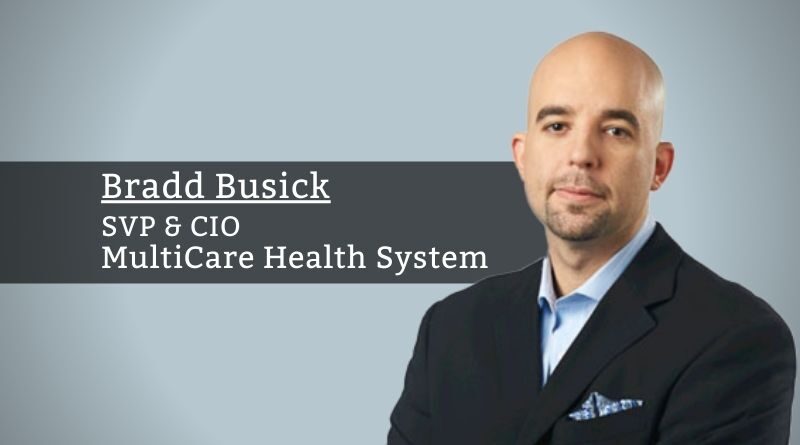Moving from “Interesting” to “Actionable”
By Bradd Busick, SVP & CIO, MultiCare Health System
While the pandemic was a prime opportunity to drive innovation, cultural and procedural change in support of patient safety, for years health care systems have admired and in many cases, been handcuffed to critical equipment in our facilities that lacked the needed stability to provide exceptional patient care. The equipment in our facilities is often only noticed when something goes wrong and as such, have forced both facilities and clinical teams to adopt a reactive vs. proactive posture.
To continue our digital transformation, MultiCare Health System has embarked on a journey of identifying our core capabilities across the system, their current maturity, and their relative alignment to our strategic objectives. Once identified, we articulated the system benefits, associated costs, and timing, resulting in a clear and concise capability roadmap that thoughtfully sequences our digital needs. As it relates to our imaging equipment, using data to make informed decisions is one of those capabilities that was identified as an opportunity to improve.
High Reliability Organization (HRO)
MultiCare believes in the power of being a High Reliability Organization (HRO). HROs thrive on transparency and managing the unexpected, while being observant and focused on predicting and eliminating catastrophes rather than reacting to them. MultiCare’s culture doesn’t tolerate patient care disruption and embraces an approach to care steeped in transparency and proactive measures. To this end, we continue our investment in patient care by providing proactive and predictive notifications on imaging equipment uptime while increasing machine utilization via our investment in Glassbeam.
The Glassbeam platform allows us to leverage remote diagnostic capabilities, so our BioMed staff avoid unnecessary travel and can remotely manage and troubleshoot issues proactively. This vastly improves machine uptime and utilization across the entire fleet of imaging modalities and moves us from viewing data that is interesting, to data that is actionable.
MultiCare took a unique approach in re-designing the Information Services & Technology team, creating a vertical focused specifically on People, Places, and Productivity (P3).
Putting the People behind the Process
While many organizations claim to be data-driven, very few actually use the data gathered due to the inability to quickly identify the opportunity or staff the effort associated with the proposed fix. MultiCare took a unique approach in re-designing the Information Services & Technology team, creating a vertical focused specifically on People, Places, and Productivity (P3). This team is designed to monitor, identify and address anomalies identified in our imaging equipment in partnership with our providers. Technology solutions can bring people together to spark creativity and magnify results, and P3 is structured so providers can be more productive, while stretching the boundaries of how they work via low-friction, highly reliable solutions.
By levering artificial intelligence and machine learning, we’re able to optimize our capital budgets for expensive imaging assets. Additionally, we become more intentional about equipment utilization by procedure, machine, operator, and facility, ensuring that we’re able to provide the right level of care at the time of need.
This cloud-based, IoT-enabled capability is designed to analyze large quantities of telemetry, while leveraging existing rule sets and prerequisites in support of early issue detection. It is through the identification of risks before they interrupt patient care that allows us to provide a new level of consistency in our support and preventative execution.
Once identified, we’ve automated the notification and dispatch, providing real-time, actionable insights to decision-makers regarding the status, health, and next steps associated with equipment. This integrated structure between the BioMed and Desktop team provides transparency and support, resulting in enhanced patient satisfaction and better operational results.
Operationally Driven – Technology Enabled
Based on the capability roadmap, our business and technology strategies quickly converge, allowing MultiCare to blur the lines between IS&T and the business. To structurally support this intentional partnership, IS&T has transformed to be more agile, collaborative, and patient-focused through thoughtful re-design and partnership.
While our investment in enhanced telemetry is based on a technology platform, it is operationally driven as we provide real-time monthly snapshots to hospital leadership, articulating the avoided downtime, bottom-line savings, and preventative maintenance costs. This new capability addresses the fluidity, value creation, and resilience needed between the business and their IT department as the goals and objectives of enhanced uptime, patient safety, and continuation of care are surgically addressed. It is through the alignment of system strategy with technological capabilities that the partnership is further enhanced.
As the CIO, operating at the intersection of our system strategies and IT to deliver tangible value is paramount. In parallel with digital transformation, we are also undergoing an operating model transformation to better support the enterprise impact, requiring more accountability and transparency from our IS&T Centers of Excellence. Through these approaches, MultiCare will continue to be the Pacific Northwest’s highest value system of health for our community.



